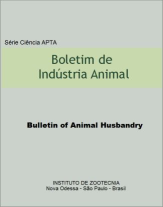Carcass morphology and quality of goat from the region of €œAlto Camaqu〠slaughtered at different ages.
DOI:
https://doi.org/10.17523/bia.v72n3p193Keywords:
leg, loin, quality trait, tissue compositionAbstract
The objective of this study was to evaluate the carcass morphology and quality of goats slaughtered at 8-9 and 11-12 months of age, which were reared extensively in the region of €œAlto Camaquã€, Rio Grande do Sul, Brazil. The carcasses of 37 male castrated goats, including 14 animals slaughtered at 8-9 months of age and 23 at 11-12 months, were evaluated. The following five cuts were obtained from the right half-carcass: foreleg, hind leg, fluctuating ribs plus loin and flank, fixed ribs and chest. These cuts were then dissected for determination of the composition of muscle, bone, subcutaneous fat, intermuscular fat, and other tissues. There was a significant difference in hot carcass yield, commercial cut yield, cooling losses, carcass and leg length, and leg and chest depth between slaughter ages. An interaction between slaughter age and carcass cut was observed for muscle/fat ratio, muscle percentage, total fat, intermuscular and subcutaneous fat, and weight and percentage of other tissues. There was an effect of slaughter age, regardless of cut, on the variables bone, muscle, total cut weight, muscle/bone ratio and bone percentage. Commercial cut yield and hot carcass weight increase with age. However, the tissue composition of animals slaughtered at a younger age is characterized by a better muscle/fat ratio in the different cuts.Downloads
Downloads
Published
Issue
Section
License
Os autores não serão remunerados pela publicação de trabalhos, pois devem abrir mão de seus direitos autorais em favor deste periódico. Por outro lado, os autores ficam autorizados a publicar seus artigos, simultaneamente, em repositórios da instituição de sua origem, desde que citada a fonte da publicação original seja Boletim de Indústria Animal. A revista se reserva o direito de efetuar, nos originais, alterações de ordem normativa, ortográfica e gramatical, com vistas a manter o padrão culto da língua e a credibilidade do veículo. Respeitará, no entanto, o estilo de escrever dos autores. Alterações, correções ou sugestões de ordem conceitual serão encaminhadas aos autores, quando necessário. Nesses casos, os artigos, depois de adequados, deverão ser submetidos a nova apreciação. As opiniões emitidas pelos autores dos artigos são de sua exclusiva responsabilidade. Todo o conteúdo deste periódico, exceto onde está identificado, está licenciado sob a Licença Creative Commons Attribution (CC-BY-NC). A condição BY implica que os licenciados podem copiar, distribuir, exibir e executar a obra e fazer trabalhos derivados com base em que só se dão o autor ou licenciante os créditos na forma especificada por estes. A cláusula NC significa que os licenciados podem copiar, distribuir, exibir e executar a obra e fazer trabalhos derivados com base apenas para fins não comerciais.













